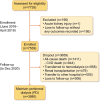Machine learning for identification of short-term all-cause and cardiovascular deaths among patients undergoing peritoneal dialysis
- PMID: 40040752
- PMCID: PMC11879343
- DOI: 10.1093/ckj/sfae242
Machine learning for identification of short-term all-cause and cardiovascular deaths among patients undergoing peritoneal dialysis
Abstract
Although more and more cardiovascular risk factors have been verified in peritoneal dialysis (PD) populations in different countries and regions, it is still difficult for clinicians to accurately and individually predict death in the near future. We aimed to develop and validate machine learning-based models to predict near-term all-cause and cardiovascular death. Machine learning models were developed among 7539 PD patients, which were randomly divided into a training set and an internal test set by five random shuffles of 5-fold cross-validation, to predict the cardiovascular death and all-cause death in 3 months. We chose objectively collected markers such as patient demographics, clinical characteristics, laboratory data, and dialysis-related variables to inform the models and assessed the predictive performance using a range of common performance metrics, such as sensitivity, positive predictive values, the area under the receiver operating curve (AUROC), and the area under the precision recall curve. In the test set, the CVDformer models had a AUROC of 0.8767 (0.8129, 0.9045) and 0.9026 (0.8404, 0.9352) and area under the precision recall curve of 0.9338 (0.8134,0.9453) and 0.9073 (0.8412, 0.9164) in predicting near-term all-cause death and cardiovascular death, respectively. The CVDformer models had high sensitivity and positive predictive values for predicting all-cause and cardiovascular deaths in 3 months in our PD population. Further calibration is warranted in the future.
Keywords: CVD; Transformer; chronic kidney disease; machine learning; mortality; peritoneal dialysis.
© The Author(s) 2024. Published by Oxford University Press on behalf of the ERA.
Conflict of interest statement
None declared.
Figures
References
-
- Fresenius Medical Care 2020 Annual Report. Fresenius Medical Care, 2020.
-
- Ministry of Health, PR China. Chinese National Renal Data System. http://www.cnrds.net (3 August 2020, date last accessed).
LinkOut - more resources
Full Text Sources




